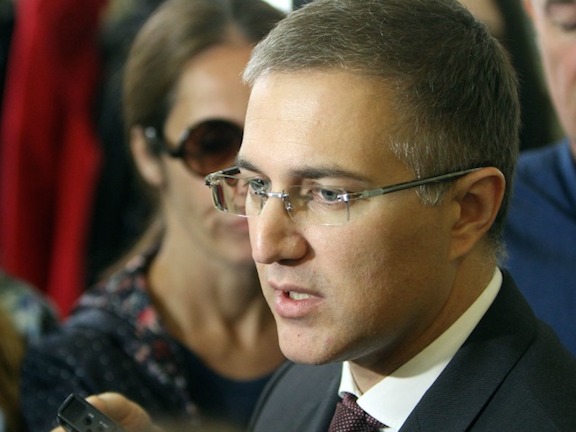

However, eight months after the incident, the only court action related to the case is not against the direct or indirect perpetrators of this event but against the weekly magazine NIN, which, on its front page, ran a story about the responsibility of the Interior Minister for the police action [or lack of it] in Savamala.
Like the demolition act itself, the case against NIN highlights the deficiencies in Serbia’s rule of law even if, in the long run, the court case leads to new findings related to the Savamala affair.
The direct culprits of the demolition project breached several constitutionally guaranteed rights of accidental bystanders and holders of family-owned businesses in Hercegovačka Street in Savamala.What was more shocking was the lack of response by the police who deliberately refused to answer numerous calls from people who had been assaulted and investigate events in Savamala.
The police’s failure to protect the citizens drew strong reactions from independent state institutions, NGOs, and the media.
After conducting an internal investigation, the Ombudsperson, Saša Janković, in his report, accused the Interior Minister, Nebojsa Stefanovic, of being complicit in the Savamala episode and urged him to apologize to citizens for the official failure to react appropriately in the matter.The Belgrade Center for Security Policy, a local research NGO, urged Stefanovic and Police Director Vladimir Rebićto resign. Finally, NIN on June 16 published a front-page article exploring minister Stefanovic’s role in the Savamala affair.
Following publication of the article, Stefanović, who is also a high-ranking official of the ruling Serbian Progressive Party, sued NIN, demanding compensation based on damage done to his professional reputation and honour.The NIN journalists and editors denied the allegation and claimed they merely exercised freedom of expression.
After a single hearing held before the Higher Court in Belgrade on November 29, the sentence in the case of Stefanovic vs. NIN was scheduled for later this month.The hearing was marked by rallies of supporters and opponents of Stefanovic in front of the court building, including senior political figures such as the Mayor of Belgrade Sinisa Mali, Belgrade City Manager Goran Vesić, and others.It was a crude attempt to put political pressure on the judiciary of a kind that is regularly pointed out and criticized in European Commission Progress Reports on Serbia.
As these reports suggest, besides problems of independence, a majority of Serbia’s judges - apart from those in the constitutional court - continue with a formalist reading of the law and keep to the ideology of bound judicial decision-making despite the ongoing process of judicial reforms.This is worrying, considering that Serbia, through the Stabilization and Association Agreement, has assumed a commitment to gradually harmonize its domestic legal norms with EU law.
This means that, in future, in order to fulfill the EU’s acquis, besides harmonizing legislation, judges must take on board the texts of European directives, their reasoning and rationale, European Court of Justice Jurisprudence, as well as the case law of the EU member states.Judges must also take into special consideration ratified international legal documents and the jurisprudence of the European Court for Human Rights, ECHR.Here is where things might get spoiled for the plaintiff, Stefanović, in his lawsuit.
If the court fails to observe the practice of the ECHR and rules in favour of Stefanovic, the ECHR itself might find itself deliberating in the case Stefanovic vs. NIN with regard to a potential breach of Article 10 of the European Convention on Human Rights.This provides for the right to freedom of expression, subject to restrictions that are “in accordance with law” and “necessary in a democratic society”.It includes the freedom to hold opinions, and to receive and impart information and ideas, but allows restrictions for protection of the reputation or the rights of others.
The minister should note that the ECHR has on numerous occasions underlined the significance of the independent investigative journalism.It explicitly reiterated in January 2013 that, “In a democratic system the acts or omissions of government must be subject to the close scrutiny not only of the legislative and judicial authorities but also of the media and public opinion.”
The ECHR has also accepted that value judgments, allegations or statements can have only a slim factual basis,and even that value judgments and criticism can be based on unconfirmed allegations or rumours.
In adjudicating cases of defamation of public persons, the ECHR also balances their own right to privacy with several criteria including that person’s prior conduct.Bearing in mind Stefanović’s habit of hosting press conferences, even on less significant occurrences than the de-facto suspension of the state’s sovereignty on part of its territory, it will be interesting to observe whether the Serbian court takes this into consideration as well.
According to the ECHR practice, journalists or editors must also have an opportunity in defamation cases to rely on a defence of justification to escape civil liability.In other words, the court must not refuse to consider the factual basis for the claim of Stefanovic’s political responsibility in the Savamala affair.
In the end, in relation to Stefanović’s public function, it is noteworthy to mention Oberschlick No 2 vs. Austria, a case in July 1997 in which the ECHR concluded that the limits of acceptable media criticism are wider with regard to a politician acting in his public capacity than in relation to a private individual.
This case concerned a critical commentary by the editor of the Vienna-based periodical Forum, in which he called Jörg Haider, former leader of the far-right Austrian Liberal Party, an “idiot” (“Trottel”).Incidentally, Prime Minister Vučićused the same term to brand the mask men and their principals from Savamala.